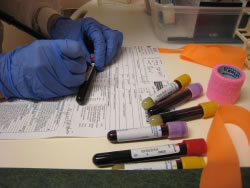You scored 0 marks out of 2.
Thyroid replacement therapy aptly demonstrates the value of therapeutic drug monitoring: Insufficient or excessive thyroxine would produce elevated levels of TSH (which is associated with increased incidence of atherosclerotic disease) or complete suppression of TSH (which is warned against) respectively, and the symptoms of hypothyroidism are too subtle to be relied upon to indicate whether therapy is optimised.

The only option remaining to the clinician and patient is periodic testing to determine TSH levels. As well as this determination of therapeutic drug levels, monitoring is often used to ensure that drugs are not present at toxic concentrations.
Commonly-monitored drugs include gentamicin and digoxin (to avoid toxicity, especially in patients with renal failure), phenytoin and IV theophylline/aminophylline (to achieve therapeutic concentrations whilst avoiding toxicity) and Vancomycin (to avoid renal toxicity and ototoxicity).
Drug level measurement is only useful once a steady state drug concentration has been achieved (after 4-5 drug half lives). High or low drug levels may result from a drug interaction - in which case the interacting drug can often be changed - or from a patient not taking their medication as prescribed. Where these easy remedies are not applicable, specialist advice may be necessary.